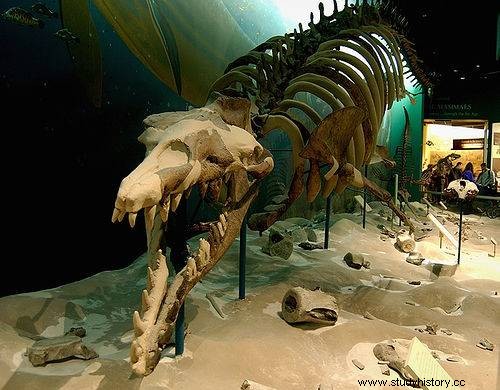The Reuters news agency recently reported that in Peru, paleontologists unearthed the skull of a great sea predator, an ancient ancestor of modern whales, that lived in a prehistoric ocean that once covered part of the country.
King Lizard
A well-preserved skull, some 36 million years old, was excavated last year in the rocks of the southern part - rich in fossils - of the Peruvian Ocucaje Desert. It has rows of long, pointed teeth, said Rodolfo Salas, head of palaeontology at the National University of San Marcos, at a press conference.

Basilosaurus cetoides skeleton at the National Museum of Natural History, Washington.
Scientists believe that the ancient mammal was Basilosaurus, belonging to the water cetacean family, whose modern descendants are whales, dolphins and porpoises. " Basilosaurus "Means" royal lizard ", although the animal was not a reptile, its long body could move like a giant snake . It is now assumed that Basilosaurus led a predatory lifestyle similar to today's killer whales or Mesozoic marine reptiles such as the Mosasaurus. It ate on fish and smaller marine mammals.
The predator was probably about 12 meters long, which is about the height of a four-story building, although some sources say up to six meters more.
- It was a sea monster. When he was looking for food, he certainly did a lot of damage Salas said, adding that the skull, which has already been on display at the university museum, may be of an entirely new species of Basilosaurus.

Scientists believe that the ancient mammal was a basilosaurus belonging to the water cetacean family, whose modern descendants are whales, dolphins and porpoises
Scientists believe that the first cetaceans evolved from mammals that lived on land about 55 million years ago, about 10 million years after the asteroid hit the ground just outside Mexico's Yucatan Peninsula, destroying most of Earth's life, including dinosaurs. / P>
Salas explained that when the ancient Basilosaurus died, its skull likely sank to the bottom of the sea, where it was quickly buried and preserved.
A fraudster who made money on the "folding skeleton"
There is also an interesting story related to the "king lizard" and its size. Well, in 1845, the German collector Albert Koch exhibited a 35-meter skeleton of an alleged sea serpent, first in New York and then traveled with him around the world. He called it Hydrarchos and claimed to have found it in Clarksville, Alabama. He argued that the presented remains are arranged in a natural order, in the same order as he found them.

Koch and his skeleton
It turned out, however, that Albert Koch was a fraud. The skeleton on display consisted of parts of at least five different specimens of Basilosaurus and was eventually destroyed in the Great Chicago Fire.
